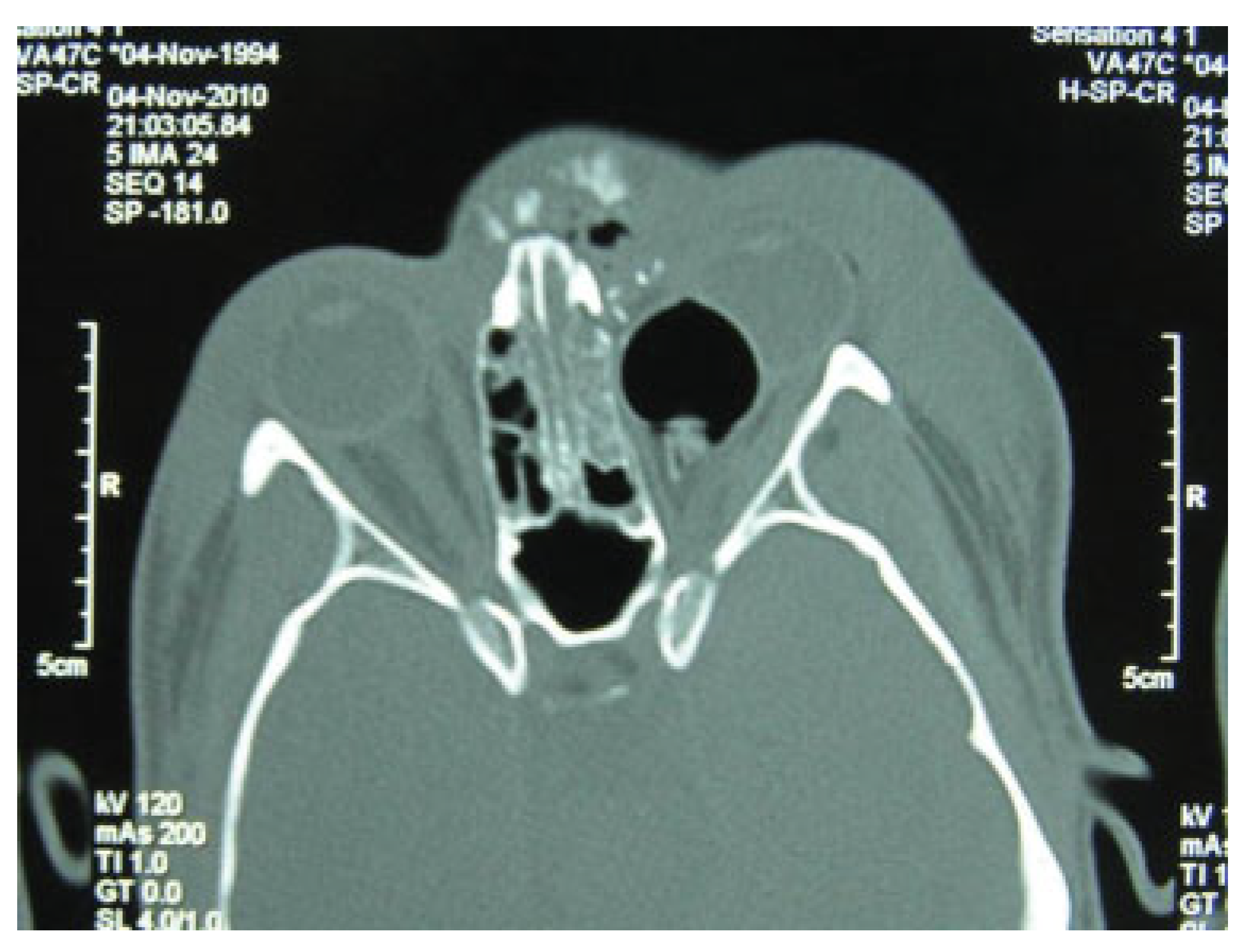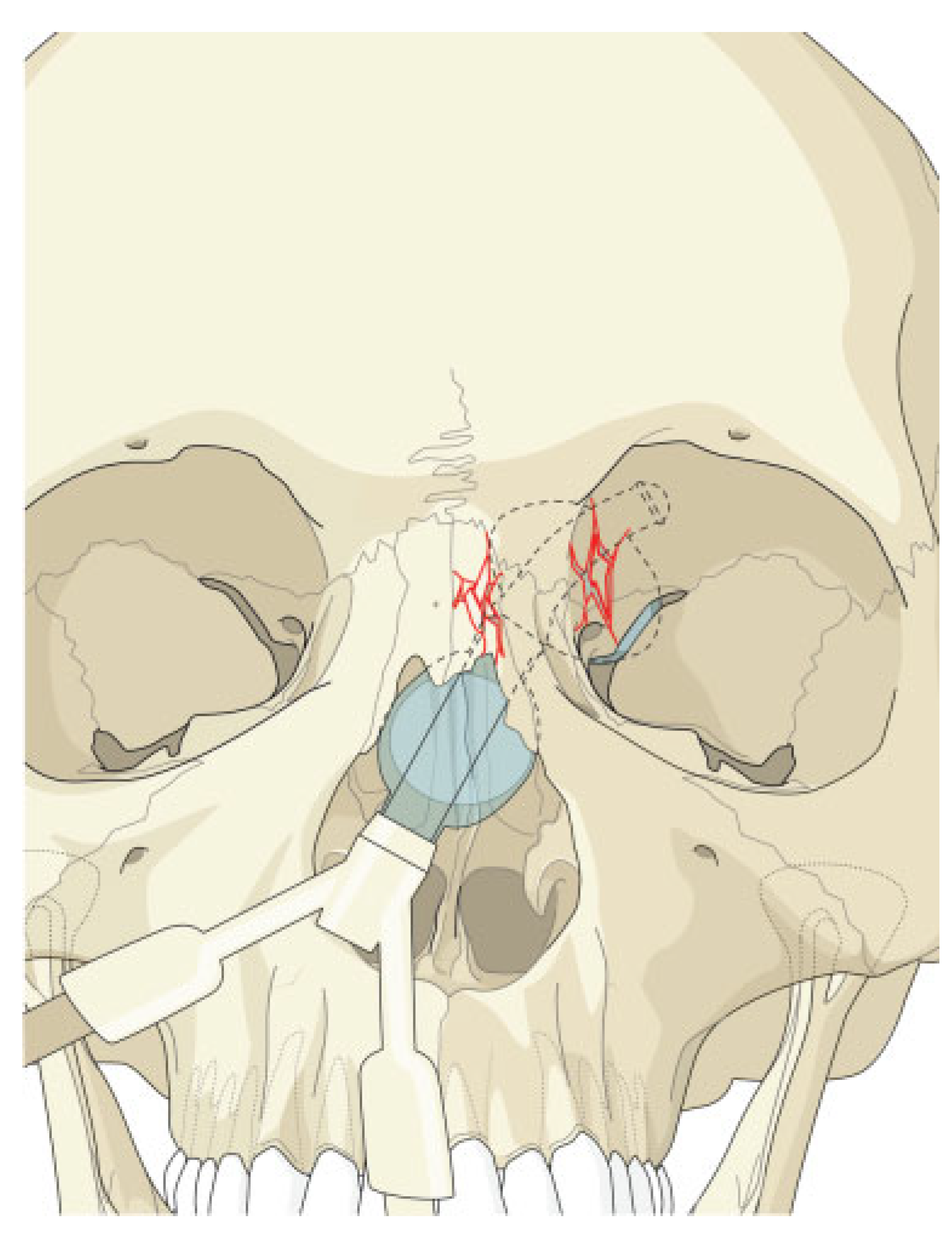Iatrogenic Oculocardiac Reflex in a Patient with Head Injury
Abstract
:Case Report
Discussion
References
- Kim, J.; Lee, H.; Chi, M.; Park, M.; Lee, J.; Baek, S. Endoscope-assisted repair of pediatric trapdoor fractures of the orbital floor: Characterization and management. J. Craniofac. Surg. 2010, 21, 101–105. [Google Scholar] [CrossRef] [PubMed]
- Campbell, R.; Rodrigo, D.; Cheung, L. Asystole and bradycardia during maxillofacial surgery. Anesth. Prog. 1994, 41, 13–16. [Google Scholar] [PubMed]
- Blanc, V.F.; Hardy, J.F.; Milot, J.; Jacob, J.L. The oculocardiac reflex: A graphic and statistical analysis in infants and children. Can. Anaesth. Soc. J. 1983, 30, 360–369. [Google Scholar] [CrossRef] [PubMed]
- Locke, M.M.; Spiekermann, B.F.; Rich, G.F. Trigeminovagal reflex during repair of a nasal fracture under general anesthesia. Anesth. Analg. 1999, 88, 1183–1184. [Google Scholar] [PubMed]
- Robideaux, V. Oculocardiac reflex caused by midface disimpaction. Anesthesiology 1978, 49, 433. [Google Scholar] [CrossRef] [PubMed]
- Sires BS, Stanley RB Jr, Levine LM. Oculocardiac reflex caused by orbital floor trapdoor fracture: An indication for urgent repair. Arch. Ophthalmol. 1998, 116, 955–956. [Google Scholar]
- Chesley, L.D.; Shapiro, R.D. Oculocardiac reflex during treatment of an orbital blowout fracture. J. Oral. Maxillofac. Surg. 1989, 47, 522–523. [Google Scholar] [CrossRef] [PubMed]
- Gomez, T.M.; Van Gilder, J.W. Reflex bradycardia during TMJ arthroscopy: Case report. J. Oral. Maxillofac. Surg. 1991, 49, 543–544. [Google Scholar] [CrossRef] [PubMed]
- Kosaka, M.; Asamura, S.; Kamiishi, H. Oculocardiac reflex induced by zygomatic fracture; a case report. J. Craniomaxillofac Surg. 2000, 28, 106–109. [Google Scholar] [CrossRef] [PubMed]
- Osborn, T.M.; Ueeck, B.A.; Ham, L.B.; Assael, L.A. A case of asystole from periorbital laceration manipulation and oculocardiac reflex in an acute trauma setting. J. Trauma. 2008, 65, 228–230. [Google Scholar] [CrossRef] [PubMed]
- Lee, W.T.; Kim, H.K.; Chung, S.M. Relationship between small-size medial orbital wall fracture and late enophthalmos. J. Craniofac Surg. 2009, 20, 75–80. [Google Scholar] [CrossRef] [PubMed]
- Yano, H.; Suzuki, Y.; Yoshimoto, H.; Mimasu, R.; Hirano, A. Linear-type orbital floor fracture with or without muscle involvement. J. Craniofac Surg. 2010, 21, 1072–1078. [Google Scholar] [CrossRef] [PubMed]
- Matic, D.B.; Tse, R.; Banerjee, A.; Moore, C.C. Rounding of the inferior rectus muscle as a predictor of enophthalmos in orbital floor fractures. J. Craniofac Surg. 2007, 18, 127–132. [Google Scholar] [CrossRef] [PubMed]


© 2008 by the author. The Author(s) 2008.
Share and Cite
Stathopoulos, P.; Mezitis, M.; Kostakis, G.; Rallis, G. Iatrogenic Oculocardiac Reflex in a Patient with Head Injury. Craniomaxillofac. Trauma Reconstr. 2012, 5, 235-237. https://doi.org/10.1055/s-0032-1322532
Stathopoulos P, Mezitis M, Kostakis G, Rallis G. Iatrogenic Oculocardiac Reflex in a Patient with Head Injury. Craniomaxillofacial Trauma & Reconstruction. 2012; 5(4):235-237. https://doi.org/10.1055/s-0032-1322532
Chicago/Turabian StyleStathopoulos, Panagiotis, Michael Mezitis, George Kostakis, and George Rallis. 2012. "Iatrogenic Oculocardiac Reflex in a Patient with Head Injury" Craniomaxillofacial Trauma & Reconstruction 5, no. 4: 235-237. https://doi.org/10.1055/s-0032-1322532
APA StyleStathopoulos, P., Mezitis, M., Kostakis, G., & Rallis, G. (2012). Iatrogenic Oculocardiac Reflex in a Patient with Head Injury. Craniomaxillofacial Trauma & Reconstruction, 5(4), 235-237. https://doi.org/10.1055/s-0032-1322532


